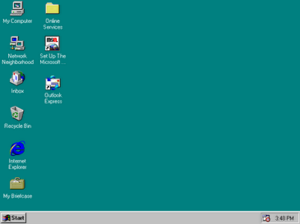 | |
 Screenshot of Windows 95, the first version of Windows in the 9x series | |
| Developer | Microsoft |
|---|---|
| OS family | MS-DOS |
| Working state | Discontinued |
| Source model | Closed source |
| Initial release | July 14, 1995 (as Windows 95) |
| Final release | 4.90.3000 / June 19, 2000 (as Windows Me) |
| Update method | Windows Update |
| Platforms | IA-32 |
| Kernel type | Monolithic (DOS) |
| Userland | Windows API |
| Default user interface | Windows shell (Graphical) |
| License | Proprietary commercial software |
| Preceded by | Windows 3.1 (1992-1993) |
| Succeeded by | Windows XP (2001) |
| Support status | |
| Mainstream support for Windows 95 ended on December 31, 2000. Extended support ended on December 31, 2001.[1] Mainstream support for Windows 98 ended on June 30, 2002. Mainstream support for Windows Me ended on December 31, 2003. Extended support for both 98 and Me ended on July 11, 2006.[2][3] | |
Windows 9x is a generic term referring to a line of discontinued Microsoft Windows operating systems from 1995 to 2000, which were based on the Windows 95 kernel and its underlying foundation of MS-DOS,[4] both of which were updated in subsequent versions. The first version in the 9x series was Windows 95, which was succeeded by Windows 98 and then Windows Me, which was the third and last version of Windows on the 9x line, until the series was superseded by Windows XP.[5]
Windows 9x is predominantly known for its use in home desktops. In 1998, Windows made up 82% of operating system market share.[6]
The internal release number for versions of Windows 9x is 4.x. The internal versions for Windows 95, 98, and Me are 4.0, 4.1, and 4.9, respectively. Previous MS-DOS-based versions of Windows used version numbers of 3.2 or lower. Windows NT, which was aimed at professional users such as networks and businesses, used a similar but separate version number between 3.1 and 4.0. All versions of Windows from Windows XP onwards are based on the Windows NT codebase.
- ^ "Microsoft Support Lifecycle". Microsoft. Retrieved April 12, 2019.
- ^ "Microsoft Support Lifecycle". Microsoft. Retrieved April 12, 2019.
- ^ "Microsoft Support Lifecycle". Microsoft. Retrieved April 12, 2019.
- ^ Lea, Graham (1998-03-23). "Caldera shows Windows on DR-DOS, denying Microsoft claims". CeBIT news. Hanover, Germany. Archived from the original on 2012-03-15. Retrieved 2012-03-15.
- ^ The term Windows 9x/Me is usually used to refer to the three operating systems, as in this tutorial. Sometimes Windows Me is included as a member of Windows 9x, e.g in this version list Archived June 19, 2010, at the Wayback Machine. In this article the term Windows 9x is used to include Windows 95, 98, and Me.
- ^ Polsson, Ken (April 22, 2008). "Chronology of Microsoft Windows Operating Systems". www.islandnet.com. Archived from the original on May 2, 2008. Retrieved April 20, 2019.